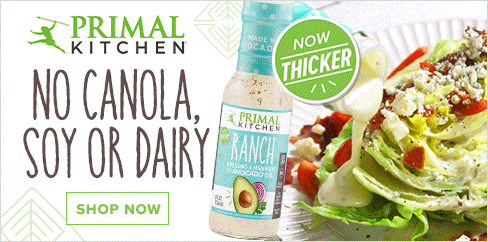Mark Sisson's Blog, page 49
April 22, 2021
Ask a Health Coach: The Adaptation Edition
 Hey folks! In this week’s Ask a Health Coach, Erin is talking all about adaptation – from how long it really takes to become fat adapted to dealing with self-sabotage and how to get off the Standard American Diet rollercoaster for good. Keep sending your questions our way in the Mark’s Daily Apple Facebook group or comments below.
Hey folks! In this week’s Ask a Health Coach, Erin is talking all about adaptation – from how long it really takes to become fat adapted to dealing with self-sabotage and how to get off the Standard American Diet rollercoaster for good. Keep sending your questions our way in the Mark’s Daily Apple Facebook group or comments below.
Stacey asked:
“I’m three weeks into a strict keto diet, and I’ve only lost a few pounds. This seems very slow compared to what everyone else reports. Do you have any tips for expediting fat loss?”
If it were as simple as meticulously monitoring your macros, everyone would be low-carbing their way to a six-pack. Listen, fat loss can be stubborn. And it’s not just reliant on what you eat or how many calories you torch. Every signal your body receives from the environment affect how your genes express themselves.
Not only that, your attitude towards your endeavour matters too. That includes your mindset, your mood, and any expectations you may have. So, if you expect that you should be dropping more weight than you have, you’re already setting yourself up for disappointment.
Stop Comparing Yourself to OthersExpectations vs reality is a challenge that most people (myself included) wrestle with in nearly every aspect of their lives. What makes you think you should be further along in your fat loss journey than you are? Is it because other people have?
You might not even be aware that you’re doing it, but my guess is that you are doing some amount of comparing and judging. Although it’s in our human nature to do so, it’s not a useful way to spend your time and energy.https://www.ncbi.nlm.nih.gov/pmc/arti... And it’s a sure-fire recipe for unhappiness, discouragement, and jealousy. After all, how you measure up to someone else’s success is none of your business.
This is a great place to practice, as they say, staying in your own lane. Focusing on your habits, your goals, and how you’ll stay accountable is going to be much more beneficial.
There’s Also an Adaptation Period
Keto adaptation, also called fat adaptation is the process your body goes through as it changes its preferred source of fuel. You’ve likely heard that this adaptation period takes about 10 days before you start to see any positive effects, but it can take longer.
In fact, sometimes it takes up to twelve weeks for the body to adapt to using fat for energy. So, my advice is, be patient.https://www.ncbi.nlm.nih.gov/pmc/arti... Probably not what you want to hear, but re-evaluating your expectations – that fat loss may not happen for you within a few weeks – is going to help you in the long run.
While your body is adapting to using this new type of fuel, have some compassion for the rest of you. As you know, keto isn’t a quick fix diet (nor should it be). Set yourself up for success by being kind to yourself, adjusting your habits and expectations, and deciding you’re in it for the long-term – no matter what your friends or people in your online keto groups are reporting.
Ken asked:
“Is it true that feeling “hangry” is pretty much low blood sugar for the unadapted? Would love to hear your in-the-know definition.”
Hangry is officially defined as being irritable or angry because of hunger. It’s when you feel so famished that you fly off the handle at even the smallest annoyance. And it has everything to do with blood sugar.
If you’re still eating a Standard American Diet, being hangry sort of comes with the territory, as does Type 2 Diabetes.https://www.ncbi.nlm.nih.gov/pmc/arti... That’s because when you eat highly processed or highly starchy food or regularly grab something snacky, your blood sugar stays up. Then, if you don’t continue to restoke the carb fire with your eat-every-two-hours routine, the level of glucose in your blood drops. When it gets too low, it triggers a cascade of hormones, including the stress hormone cortisol and adrenaline, the fight-or-flight hormone.
That cortisol-adrenaline combo is what causes that hangry feeling in some people.
How to Turn Hangry into HungryThe good news is that you’re listening to your body. You’re aware of what’s happening. Knowing when that hangry feeling comes on gives you an opportunity to change it. I always recommend answering hunger with a meal, especially for clients who are making the switch from a SAD diet.
Every time you answer your hunger with a food that supports your metabolic health, you’re adapting your response to blood sugar fluctuations. I’m not talking about just forgoing your daily muffin and OJ, I’m talking about choosing high-protein, higher-fat foods that are satiating, tasty, and keep your blood sugar stable.
Hunger Isn’t Something to Be FearedEating a paleo-centric diet most of the time is a great way to do that since it eliminates those blood sugar spikes and drops. Plus, it helps reduce your body’s ghrelin levels (aka the hunger hormone), which not only keeps you fuller for longer; it plays a major role in bone metabolism and muscle atrophy.https://www.ncbi.nlm.nih.gov/pmc/arti...
Remember that hunger itself isn’t a problem. Getting the signal that you feel hungry is your body’s way of telling you it needs more fuel. Here’s what it’s not:
A reason to deprive yourself more or beat yourself upA confirmation that your willpower is sufferingThe message that staying hungry = losing weightAn excuse to binge on all the snacks and totally ignore your satiation signalsDiet culture has trained us to believe that hunger should be feared. It’s not. Food isn’t meant to be miserable, and hunger isn’t meant to be ignored. If it really is hunger vs “hanger”, consider it a sign that your body is increasing its requirements for optimal function, which is always a good thing.
Jackie asked:
“I’m seriously failing eating Primally even though it started out well. For some reason, I have started to snack in the evenings, and finding it hard to stick to it. My motivation just doesn’t seem to be there, or I’m sabotaging myself in some way. Got any tips to help me get back on track?”
It’s easy to think that once you have the hang of something – whether it’s a new job, a new routine, or a new way of eating, everything should fall into place. The thing is though, the path to success is often paved with setbacks. And your new-found evening snacking is likely one of many on the horizon.
Changing behaviours for the long-term takes time and patience. It’s never a linear journey either. There’s usually a mix of wins, fails, and moments of self-sabotage.
Self-Sabotage is Part of the ProcessIt’s also a way to protect yourself. Change is scary, and your brain loves to keep you safe, even if that means keeping you exactly where you are, evening snack and all. When your logical, conscious mind is at odds with your subconscious mind (the side of you that believes you DESERVE a bowl of ice cream before bed), your inner critic tries to protect you by sabotaging your efforts.
The big question to ask yourself is: Why are you self-sabotaging? Take a few minutes to really think about this and jot down whatever comes up for you.
Reasons You Might Be Sabotaging Yourself:Your inner critic is running the show telling you that you aren’t worthy of successYou tell yourself you’re no good at sticking with thingsYou think it needs to be perfect (FYI, it doesn’t)You’ve neglected to set your environment up for successIt’s outside of your current comfort zone (and that’s okay)You have a fear around what will happen if you succeedYou worry that you can’t handle itYou’ve lost touch with your whyGet Reacquainted with Your WhyYour why is a belief, cause, or purpose that drives your behaviours. I always recommend starting here before embarking on any big change, because when the going gets tough, which it usually does, you’ll need something to remind you of why you embarked on it in the first place.
The concept of why is based in the tenets of the biology of human decision making, and it impacts every action you take.https://www.ncbi.nlm.nih.gov/pmc/arti... Also, it can only come from within you. So, if you’re following a paleo diet because your spouse wants you to or that it’s the trendy thing to do, try a little more self-reflection. You might find that the reasons that really resonate with you go deeper than you think.
Got anything to add? Share your strategies for dealing with adaptation in the comments below.
(function($) { $("#dfnlJxa").load("https://www.marksdailyapple.com/wp-ad..." ); })( jQuery ); 
References https://www.ncbi.nlm.nih.gov/pmc/articles/PMC4222713/https://www.ncbi.nlm.nih.gov/pmc/articles/PMC6410243/https://www.ncbi.nlm.nih.gov/pmc/articles/PMC5426415/https://www.ncbi.nlm.nih.gov/pmc/articles/PMC4049314/https://www.ncbi.nlm.nih.gov/pmc/articles/PMC4451179/
The post Ask a Health Coach: The Adaptation Edition appeared first on Mark's Daily Apple.



April 21, 2021
8 Aerobic Workouts That Aren’t Running, Cycling, or Swimming
 Aerobic workouts are gentle training sessions where the predominate form of energy being utilized is fat—mostly body fat. They’re easy, some would say “too easy,” but that’s the entire point. Aerobic workouts slowly build mitochondrial density and teach your body to burn fat. They’re essential, and they aren’t what I talk about when I talk about “chronic cardio,” which is the kind of unsustainable moderate-to-high intensity, high volume training that breaks you down and damages your health. Aerobic training is long, slow, easy, gentle, and most of all productive. If you want to be a fat-burning beast, if you want to become metabolically flexible, if you want your baseline capacity for aerobic activity, you have to do aerobic workouts.
Aerobic workouts are gentle training sessions where the predominate form of energy being utilized is fat—mostly body fat. They’re easy, some would say “too easy,” but that’s the entire point. Aerobic workouts slowly build mitochondrial density and teach your body to burn fat. They’re essential, and they aren’t what I talk about when I talk about “chronic cardio,” which is the kind of unsustainable moderate-to-high intensity, high volume training that breaks you down and damages your health. Aerobic training is long, slow, easy, gentle, and most of all productive. If you want to be a fat-burning beast, if you want to become metabolically flexible, if you want your baseline capacity for aerobic activity, you have to do aerobic workouts.
But not everyone wants to do running, cycling, or swimming. So today I’m going to give you some different options for aerobic workouts.
How to Stay In the Aerobic Fat-Burning ZoneIf you haven’t already, pick up a copy of Primal Endurance or read my posts on the subject to understand why training in the fat-burning zone is so important for everyone. Then, use these tips for staying in the aerobic zone:
Calculate and stay under the aerobic threshold. Subtract your age from 180 to get the aerobic threshold. 180 minus age—that’s the max aerobic heart rate. Do not exceed it.Wear a heart monitor or heart rate monitor. Until you can monitor your aerobic threshold intuitively through feel alone, you’ll want to use a device that tracks your heart rate or pulse and make sure you never stray above the “180 minus age” threshold discussed above.Breathe through your nose the entire time. Nasal breathing is not just more efficient and beneficial, it’s also an indicator of low enough intensity. Mouth breathing implies you’ve left the aerobic zone.Make sure you can hold a conversation the entire time. Holding a normal conversation without gasping for breath or taking long pauses to gather your strength means you’re performing a sufficiently-gentle aerobic session.Alternate Aerobic Workouts
Here are some ideas for you to try.
Uphill walkingFind a big hill. Find a long uphill hike. Find some steep staircases. Find a gradually increasing grade, in other words, and walk up it. The best way to do this is to walk a long trail or neighborhood with steep grades and rolling hills and switchbacks. You could do it on a treadmill with the steep incline or walk up and down the same hill, but that’s not as interesting as a long walk through varied terrain.
Burpee treadmillNo, don’t do burpees on a treadmill. There’s no machine involved.
With burpee treadmills, you do normal speed burpees, but only 1-3 every 30 seconds. You just keep that going, doing the max number of burpees per 30 seconds that allows you to stay under the aerobic threshold. You shouldn’t be out of breath for this.
Standup paddlingThis is the best choice. This is not my opinion. It is cold, hard, objective fact that standup paddling is the superior form of movement. Maybe 30-40% of my “aerobic training” takes place on top of my standup paddle board because I love doing it. A nice bonus is that it’s also a great aerobic workout.
Loaded walks (rucking)Strap on a weight vest of a backpack filled with books and go for a walk. The added weight will increase the intensity of the walk enough that your HR flirts with the aerobic threshold but it’ll remain easy enough so you don’t go over.
One of my friends loves to set the treadmill at max incline and hold one 25 pound dumbbell. Then he just walks, switching hand positions every 30 seconds (overhead with left arm, holding it at your side with right arm, resting on your shoulder, etc) for 30-40 minutes while staying under the aerobic threshold. This can also happen, obviously, out in the real world on real trails and paths.
Floor-based movement flowYou ever get down on the ground and just move around on all fours, swapping between different positions, crawling, somersaulting, cartwheeling, rolling over, planking, doing a push-up, shoulder rolling? It’s fun, it can be highly aerobic, and it can be done while doing other things like watching TV or listening to a podcast.
Slow “Cindy”One of my favorite CrossFit workouts is Cindy, which tasks you with doing rounds of 5 pull-ups, 10 push-ups, and 15 bodyweight squats as many times as you can in a set period of time. Most people do this at high intensity. A fun twist is to make it aerobic: set a timer for 45 minutes, strap on the heart rate monitor and do Cindy, only slow. Take your sweet time doing the pull-ups, push-ups, and squats. Don’t focus on the number of rounds. Just try to go slow and keep your heart rate in the aerobic zone.
It feels really weird at first but eventually you get into a groove and figure out the perfect pace to maintain the 180 minus age zone.
RowingRowing machine or kayak—whatever you got. Just don’t treat this like a race. You’re not trying to break any records or go at CrossFit pace. Imagine you’re taking your sweetheart out for a lovely row on the pond. Imagine you’re living in the Wind in the Willows universe, and you’re meeting the river rat and badger for a picnic in an hour down river. Take your sweet time and just row casually.
Walking lungesI once knew a guy who did all his low level cardio by doing walking lunges everywhere. It was wild. You’d see him walking down the street doing lunges. You’d see him in the grocery store doing lunges. He got so good at doing lunges that it wasn’t really a workout for him anymore. He certainly wasn’t out of breath, ever, while doing the lunges. And I will say that he had incredible leg definition.
If you do this, make sure it doesn’t become a “workout.” If your heart rate starts trending up too high, take a break from the lunges and just walk for awhile.
Energy utilization is a spectrum.These aren’t the only ways to build aerobic capacity. Energy utilization operates along a spectrum. It’s not binary. If you sprint up a hill, you’re not just burning pure glycogen because it’s high intensity. You’re still burning fat, you’re still accessing the aerobic energy pathway. It’s just that the aerobic pathway isn’t enough and you also have to dip into other forms of energy. So in a sense, all workouts are at least partially aerobic. That said, I do recommend focusing on exclusively aerobic threshold training from time to time, just to build that aerobic base and build up your fat-burning capacity. If you sprint and only sprint, you’ll be in great shape, but I think you’d be better off throwing in a lot of long walks (or paddles, or loaded walks, or hill hikes, or rowing) to complement the high intensity work.
Another benefit of low level aerobic work is the meditative aspect. I am not a formal meditator. It just doesn’t work for me. But when I’m out on the paddle board, I’m simply existing in the moment. That’s how I meditate. Could work for you, too.
Anyway, that’s what I’ve got for you. There are many ways to do aerobic workouts, not all of them requiring running, cycling, or swimming (although those are fantastic options too). I hope after today you’ll give some of these a shot and start building up your aerobic capacity.
(function($) { $("#df4iPuY").load("https://www.marksdailyapple.com/wp-ad..." ); })( jQuery ); 
The post 8 Aerobic Workouts That Aren’t Running, Cycling, or Swimming appeared first on Mark's Daily Apple.



April 20, 2021
Sustainable, Eco-friendly Kitchen Updates
 If you’re like me, you spend a ton of time in the kitchen cooking and cleaning. Between food wrappers, food scraps, and used cleaning products, most of my household waste comes from the kitchen. Hopefully, you’re already aware that you should be recycling and not wasting food, but those are the tip of the iceberg when it comes to creating an eco-friendly kitchen.
If you’re like me, you spend a ton of time in the kitchen cooking and cleaning. Between food wrappers, food scraps, and used cleaning products, most of my household waste comes from the kitchen. Hopefully, you’re already aware that you should be recycling and not wasting food, but those are the tip of the iceberg when it comes to creating an eco-friendly kitchen.
With Earth Day coming up, it’s a perfect time to increase our sustainability quotients. What does that mean? First and foremost, it means taking steps to protect the planet—reducing your carbon footprint, contributing as little as possible to the landfills, and not polluting the environment in and around your home. A sustainable lifestyle is also one that you can afford and which you find enjoyable.
Today we’re going to count down 6, 5, 4, 3, 2, 1 way(s) to be more sustainable in the kitchen. You certainly don’t have to make all these changes overnight. Start with the one that seems the most manageable or that will address your biggest area of concern. Small changes really can make a big difference, and they often cost little to nothing to implement. In fact, being eco-conscious often saves money in the long run.
Six Ways to Avoid Food WasteReducing food waste should be a top priority for anyone interesting in protecting the planet. A recent survey found that the average American household wastes almost a third of its food, adding up to an average cost of $1,866 annually.https://pubag.nal.usda.gov/catalog/68... Not only is it bad for the wallet, it also squanders the resources used to produce, package, ship, and sell that food. Here are six ways you can reduce food waste:
1. Shop more often. Fewer trips to the store may save time and a little bit of gas, but it’s not worth it if you’re letting food spoil before you get a chance to eat it.
2. Get the most out of your freezer. Freeze leftovers to eat later. Keep a bag in your freezer for vegetable scraps and bones that you can use to make stock. Place minced fresh herbs in an ice cube tray, cover them with water or olive oil, and freeze. Use these herby cubes in soups, stews, stir-fries, and sautés.
3. Learn how to store produce properly so it doesn’t spoil before you get a chance to use it. We provide some helpful tips in the 7 Days, 7 Salads Challenge.
4. Eat the whole plant. Greens from beets, radishes, celery, and even broccoli are edible and delicious. Use the trimmings from almost any vegetable in your next batch of chicken or vegetable broth.
5. Start a compost pile. In addition to vegetable waste and eggshells, you can also throw in coffee grounds and paper filters, yard waste, compostable sponges (more on this later), and even certain packaging material. For example, Primal Kitchen wraps glass containers in compostable kraft paper to protect them during shipping. No yard? No problem! Check out under-sink worm composting, also known as vermicomposting (it sounds better when you say it that way)—a great science experiment for kids!
6. Eat nose-to-tail. Use as much of the animal as possible. Learn to embrace organs both for their excellent nutritional value and so they don’t go to waste during processing.
Five Tips for Reducing Plastic Waste
You already know that plastic waste poses a massive threat to the planet’s health. It’s hard to avoid plastic entirely, but there are ways to reduce your plastic use and the amount you put in the landfills.
1. Use reusable shopping bags and produce bags. Bags made from hemp or organic cotton are ideal, but also reuse whatever plastic bags you already have in your home. When shopping in the bulk food section, bring clean bags or containers from home. Take your glass or metal containers to the customer service counter before filling them. An employee will weigh them so the cashier can subtract the tare weight when you check out. (You can do the same for the hot food bar, by the way.)
2. Stop using plastic baggies and containers to store food. Opt for glass, metal, and silicone instead. Repurpose your clean mayo jars to make salads, store nuts, and more. Stasher brand silicone bags come in different sizes and are freezer and dishwasher safe. When the bags get worn out or damaged, Stasher will provide a mailing label so you can send them back for recycling. Cool, huh?
3. Get biodegradable kitchen garbage bags. They usually cost a bit more per bag, but it’s a small investment in sustainability.
4. Buy loose leaf tea. A 2019 study concluded that tea bags can be a hidden source of microplastic pollution.https://europepmc.org/article/med/315... At least check to make sure your favorite tea comes in plastic-free bags.
5. If you’re a Keurig lover, you simply must use reusable or compostable filter cups.
Four Ways to Shop SmartReduce your environmental impact and save money!
1. Pay attention to packaging. Opt for products that are minimally packaged, and look for recycled or recyclable paper and glass. Not to toot our own horn, but there’s a reason that 85 percent of Primal Kitchen packaging is glass, and our Frozen Bowls come in PFA-free material made from upcycled sugar cane fiber.
2. Choose seasonal, local produce and animal products when possible to reduce the carbon footprint associated with shipping food around the world.
3. Shop organic if possible. Organic farming reduces the amount of synthetic fertilizer dumped into the environment. Also support farms that use sustainable farming practices even if they aren’t certified organic. The process of becoming certified is arduous and expensive, and many smaller eco-conscious farms can’t afford it.
4. Hit up secondhand stores. Buy used kitchen appliances, silverware, and dishes. Look for cast iron and stainless steel cookware that is durable enough to last for decades.
Three Cleaner Cleaning ProductsIronically, many of the tools we traditionally use to clean the kitchen have a negative environmental impact. Not so clean after all, eh?
1. Ditch traditional scrubbing sponges and dish brushes, which are major sources of plastic waste. Sponges made from cellulose, hemp, cotton fiber, and even walnuts are compostable or biodegradable. These copper scouring pads are recyclable. Look for plastic-free dish brushes made with sustainably harvested wood and natural fiber bristles.
2. Use greener cleaning solutions. Standard cleaning products contain chemicals that can contaminate our home environments and contribute to air, water, and soil pollution. Luckily, it’s possible to clean just about anything in your kitchen, and indeed your whole home, using non-toxic methods. Check out my post, How the Heck Do I Clean That?
3. Cut back on paper towels. Kitchen towels and cloth napkins are all you need, but check out these super cool paperless paper towels, aka “untowels.” For extra eco-friendly points, look for ones made from organic cotton or recycled materials.
Two Ways to Save WaterReduce the amount of water that goes down the drain with these tips.
1. Use your dishwasher. The dishwasher uses less water than handwashing, provided you run full loads. Scrape plates instead of rinsing them for added savings.
2. Install an aerator on your kitchen faucet. Aerators reduce flow and backsplash while actually increasing water pressure. They’re simple to install and cost just a few dollars. If your faucet isn’t compatible, at least try to avoid running your water at full blast all the time.
One Last Tip: Recycle!Hopefully you’re already taking advantage of your municipal recycling program, but also, do you know about Terracycle?
Terracycle allows you to order collection boxes for the things you throw away most. When the box is full, ship it back using the free shipping label they provide. They take everything from baby food pouches to plastic bottle caps to used eyeglasses.
You do have to pay for the box, and they aren’t cheap. However, if this is something you can afford, consider it a charitable donation for the planet. For a little more money, you can get a general kitchen box so you don’t have to sort your waste. Maybe your workplace would be willing to put one in the breakroom?
When it comes to sustainability, every little change counts. What’s one thing you could implement in your own kitchen right away that would make a difference?
References https://pubag.nal.usda.gov/catalog/6845457https://europepmc.org/article/med/31552738The post Sustainable, Eco-friendly Kitchen Updates appeared first on Mark's Daily Apple.



April 19, 2021
Gaining Weight Changed My Life? Kris’ Success Story
Today, we have another Success Story from a Mark’s Daily Apple reader. If you have your own success story and would like to share it with me and the Mark’s Daily Apple community, please contact me here. Thank you for reading!
 This may sound odd but I often say gaining weight actually changed my life – for the better!
This may sound odd but I often say gaining weight actually changed my life – for the better!
No, not because I was too thin, but because the changes that I made to lose that weight gave me my life back.
Several years ago I had lost over 50 pounds by doing the typical eat less, move more thing (what I now call the “old fashioned” way). It was a ton of work but I lost the weight and even maintained it for a few years. I thought I was good to go.
But then, despite the fact that I was still doing the same things I had done to lose the weight originally—micromanaging everything I ate and exercising 6 days a week—I started gaining weight again, and quite quickly.
I was frustrated, scared and at a loss. This is what I’ve always been told to do to lose weight, but now it was no longer working. What do I do now?? Eat even less? Exercise even more?
A friend introduced me to Primal and I started reading everything I could. The success stories were so inspiring!
After several months — yes months — I was hesitant because grains and beans made up a huge part of my diet. And, I was a picky eater so I thought I’d starve if I had to get rid of those.
But I had gotten to the point that I knew I had to give it a try, I didn’t know of any other option.
And you know what? It wasn’t that hard and I certainly didn’t starve! I actually loved the food that I was eating and didn’t miss that other stuff near as much as I thought I would! I found that the main thing I missed was the convenience of things like bread and tortillas rather than actually missing eating them. But there are great Primal and keto-friendly ways to get around that convenience piece.
It didn’t take long before I started noticing the difference. The weight was coming off (without ever being hungry which was HUGE!) but that wasn’t even the best part. I FELT so much better. My digestive issues went away. The bone and joint pain that I blamed on getting older was gone. Allergies dramatically improved. I had more energy, I was sleeping better and I was no longer riding the blood sugar rollercoaster.
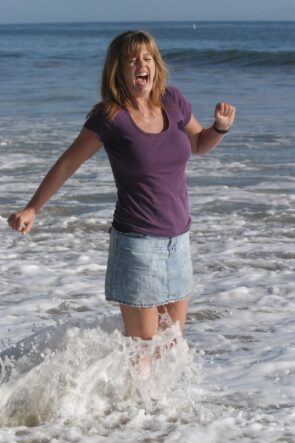 And over time (this definitely wasn’t overnight) I was actually able to get off all meds for anxiety and depression – something I never thought was even possible for me. I now feel better and stronger than I ever have—even through the craziness of 2020.
And over time (this definitely wasn’t overnight) I was actually able to get off all meds for anxiety and depression – something I never thought was even possible for me. I now feel better and stronger than I ever have—even through the craziness of 2020.
I never would have experienced these changes had I not started to gain weight again.
Eating this way (eventually incorporating keto) has changed my life in so many ways that I actually decided to become a Primal Health Coach so that I could help others make the same changes and not have to keep struggling.
I’m a lifer now! And to think I once feared giving up grains. Now, I can’t imagine eating them again!
Thanks again Mark for all you do!
Kris
Thanks for sharing your story with us, Kris. You’re an inspiration to us all, and stories like yours remind me why I do what I do. Grok on!
-Mark
(function($) { $("#dfoHRZE").load("https://www.marksdailyapple.com/wp-ad..." ); })( jQuery ); 
The post Gaining Weight Changed My Life? Kris’ Success Story appeared first on Mark's Daily Apple.



April 17, 2021
DIY Kids’ (Or Grown-up!) Bento Lunch Ideas
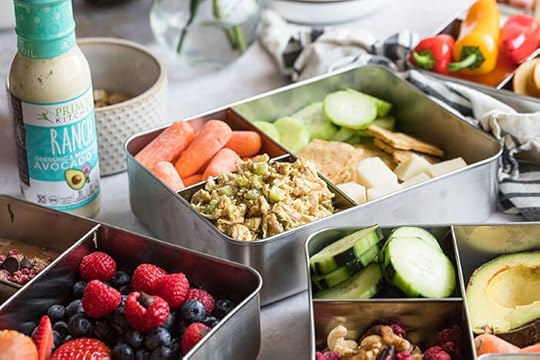 Remember sack lunches growing up? You’d unroll your brown bag to find a white bread PB&J, maybe a fruit cup, a squeezable neon green beverage. And if you got a prepackaged snack cake, you were the envy of the rest of your lunch table. These days, we want our kids to have healthier choices while they’re at school or daycare, and we want them to enjoy their food, too. Enter bento boxes, the fun way to serve a healthy, satisfying, and fun lunch on the go.
Remember sack lunches growing up? You’d unroll your brown bag to find a white bread PB&J, maybe a fruit cup, a squeezable neon green beverage. And if you got a prepackaged snack cake, you were the envy of the rest of your lunch table. These days, we want our kids to have healthier choices while they’re at school or daycare, and we want them to enjoy their food, too. Enter bento boxes, the fun way to serve a healthy, satisfying, and fun lunch on the go.
Bento boxes originated in Japan as a way to take lunch during the workday or school day. They typically have separated sections for a larger main course with smaller sections for sides.
Today, you can find bento boxes in any configuration you can dream up: toddler-sized, grown-up sized, stackable, leak-proof, sections for hot and cold food … the possibilities are endless.
The days of boring kid lunches are over. There are endless combinations for fun bento boxes for kids (and adults alike) for lunches, snacks, and everything in between. Use whatever sized containers make sense for your child (smaller for younger kids, larger for older kids) and pack accordingly. Below are some ideas for the best bento boxes that even the pickiest of eaters will enjoy!
Bento TipsThe best part of bento lunches is that there are no rules. But a few tips can ensure that you get the most out of your lunchbox efforts.
Bento lunches should be:
Balanced. To be filling, you’ll want to include protein and fat, with an amount of carbohydrates that fits into your current plan (less for keto, more for Primal).Packable. Make sure your lunch will hold up for a few hours. Will your contents turn to mush? Will your food items taste funny at room temperature? Will the box you pack in the morning make it until lunch? (Those sashimi bento boxes look pretty, but to avoid foodborne illness they’re meant to be eaten right after you assemble them.)Beautiful. Traditional bento boxes combine a variety of colors and shapes to make a visually striking eating experience.Kids’ (or Grown-ups!) Bento Box Lunch Ideas
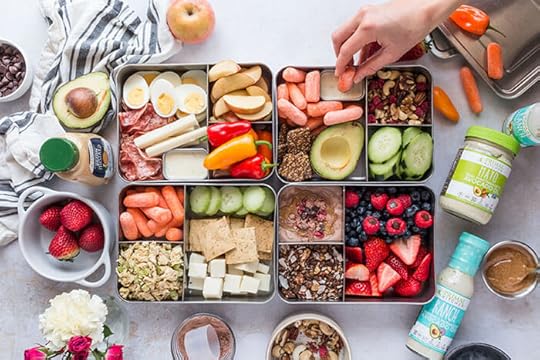
Use these as inspiration to kickstart your creativity.
Picky eater tip: if you’re introducing a new food, be sure to include a food they like along with it!
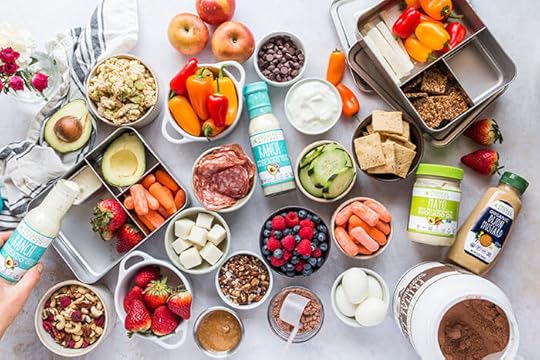

Chicken Salad, Homemade Almond Crackers, Grass-fed Cheese Cubes, Baby Carrots Sliced Cucumbers
Chicken Salad RecipeIngredients
1 lb. shredded chicken1/4 cup avocado oil mayo2 tbsp. Primal Kitchen® Dijon Mustard or Spicy Mustard1/3 cup minced apple3 stalks minced celerysalt and pepperDirections
In a bowl, combine all of the ingredients together. Season with salt and pepper to taste.
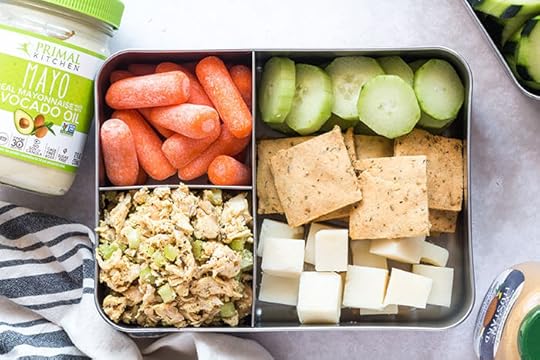
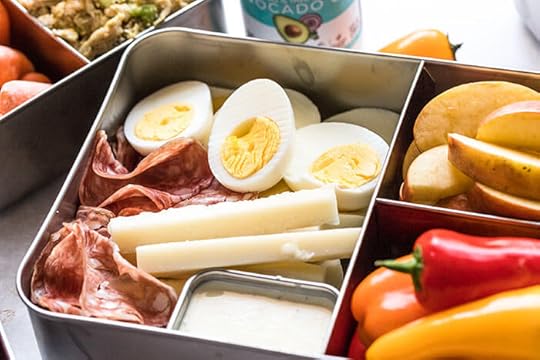
Ham, Salami or Pepperoni, Cheese Sticks, Baby Peppers, Hard Boiled Eggs, Sliced Apple, Primal Kitchen Creamy Ranch Dressing
This is a perfect lunch plate that can be made ahead of time. For tips on making the best hard and softboiled eggs, refer to our Perfect Egg Tutorial.
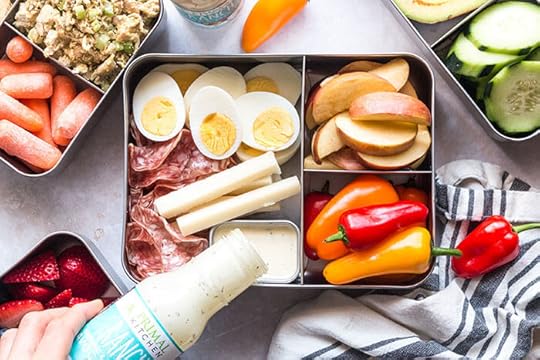
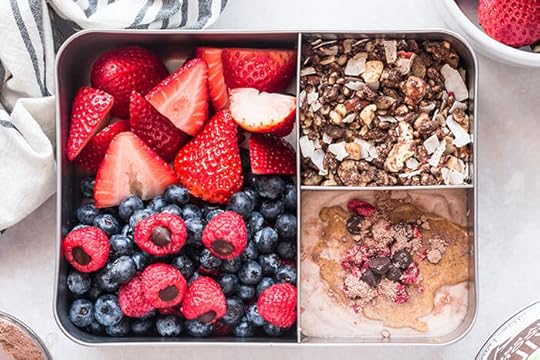
Strawberries, blueberries, and raspberries (stuffed with dark chocolate chips), Paleo or Gluten-Free Granola, Protein-boosted Yogurt
Ingredients
1 5-6 oz. container grass-fed yogurt1 scoop Primal Kitchen Chocolate Primal FuelDash of vanilla extractDrizzle of almond butterDirections
In a bowl, mix together the yogurt, protein powder and vanilla extract. Pour into the bento box and top with a drizzle of almond butter and some paleo granola or crumbled freeze-dried fruit.
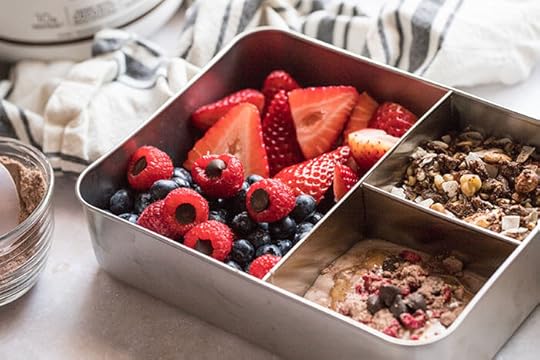
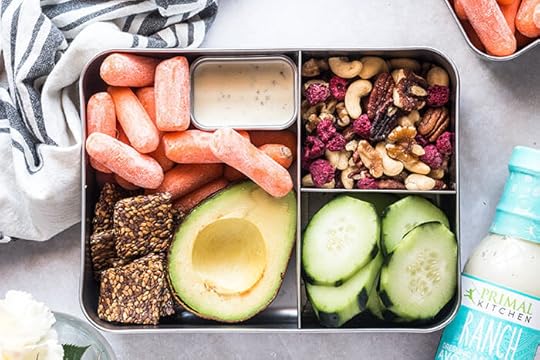
Mixed Nuts and Freeze-Dried Raspberries, Sliced Cucumber, Flackers® Crackers, Avocado, Baby Carrots, Primal Kitchen Ranch Dressing
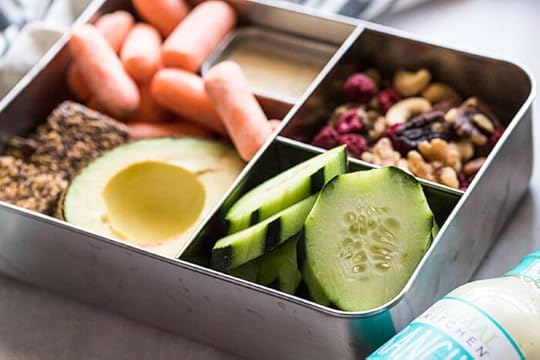
(function($) { $("#dfJFkXT").load("https://www.marksdailyapple.com/wp-ad..." ); })( jQuery ); 
The post DIY Kids’ (Or Grown-up!) Bento Lunch Ideas appeared first on Mark's Daily Apple.



April 16, 2021
New and Noteworthy: What I Read This Week—Edition 126
 Research of the Week
Research of the WeekSeaweed-based edible food packaging.
Lower omega-3 index, higher risk of degenerative rotator cuff tears.
Researches can now use cave sediments to derive ancient human DNA.
If you’ve had Covid and want the vaccine, you might only need one dose.
Episode 483: Terri Cole: Host Elle Russ chats with Terri Cole, relationship and female empowerment expert.
Episode 484: Joe Cohen: Host Brad Kearns chats with Joe Cohen about using personal genetics to optimize health and lifestyle.
Health Coach Radio: Erin and Laura chat with Natalie Gensits about marketing.
Media, SchmediaI’m sure this will go off without a hitch.
Interesting Blog PostsA comprehensive history of humans, hunting, and meat-eating.
Dietary linoleic acid and torpor.
Social NotesEverything Else
Humans can taste the difference between deuterium water and regular water.
A US senator proposes a bill to stop “Meatless Monday.”
You might be a mouth breather, but at least you’re not a leg breather.
Things I’m Up to and Interested InPodcast I enjoyed: The one I did with Jorge Cruise, the Zero Hunger Guy.
Interesting article: Can you survive medical school believing in keto?
What do you think?: Should governments continue lockdowns?
This is terrible: British Dietetic Association supports the consumption of processed food for this one weird reason.
Fascinating: Jordan Peterson talks to Wim Hof, the Iceman.
Upcoming
The people at FilterOff have created FREE online dating events specifically for the Paleo & Keto communities.
Question I’m AskingWhat’s your 5-year outlook? Where will you be? Where will the world be?
Recipe CornerI hope you’re doing sheet pan meals. This chicken and asparagus recipe is a fantastic entry point.Honey garlic salmon (honey, while being a sugar, actually reduces harmful compounds from forming during cooking when used as a marinade).Time CapsuleOne year ago (Apr 10 – Apr 16)
How to Improve Running Form: Introductory and Advanced Drills — How to run.What Your Relationship with Food Says About You — Well, what does it?Comment of the Week
“Today was a good chance to spend more time outside for me. I’ve lately been going swimming 3 days a week at Golden Gardens beach. On nice days it’s really tricky parking there, like an airport. Today when I parked I took all I needed (bathing suit, towel and a jumprope) in my grab-bag so I wouldn’t go back to my car until I was actually leaving, so as not to disappoint a line of waiting cars. Since Chopin’s 1st piano concerto was on the radio when I arrived at the park I took an extra walk in the woods.
While this beach can be so crowded it may actually be good to have a mask available, I am not about to walk on a lonely trail in the woods wearing a mask, and I feel like a cat petted backwards when I see something doing that. This is time to enjoy my main guilty pleasures: hiking without a buddy, unmasked and unshod, and listening to classical music.”
-Sound like you’ve struck a great balance, Billy Gard.
(function($) { $("#dfHdBTB").load("https://www.marksdailyapple.com/wp-ad..." ); })( jQuery ); 
The post New and Noteworthy: What I Read This Week—Edition 126 appeared first on Mark's Daily Apple.



April 15, 2021
The Benefits of Having a Beginner’s Mind
 Tell me if this sounds familiar: you’re fed up because this fat loss thing isn’t as easy as it was when you were in your 20s. Or maybe you’re frustrated because you used to love the freedom of working out at lunch and now it feels like a hassle to leave your desk and *gasp* shower twice a day.
Tell me if this sounds familiar: you’re fed up because this fat loss thing isn’t as easy as it was when you were in your 20s. Or maybe you’re frustrated because you used to love the freedom of working out at lunch and now it feels like a hassle to leave your desk and *gasp* shower twice a day.
Sometimes it’s the novelty of a new routine, a new way of eating, and new-found endorphins that makes embarking on a health journey exciting. And somehow, in the middle of unrealistic expectations, lack-of-newness, and a few discouraging setbacks, it becomes unsatisfying at best.
As a health coach, I’m trained in the nuances of how to reprogram my clients’ genes, but I’m also a seasoned pro at understanding the psychology behind what makes them successful versus what makes them continue to beat their head against the wall wondering why everything seems like such a freakin’ chore.
I’ll let you in on a little secret. To get where you really want to go, you’ve got to maintain what experts call, a beginner’s mind.
A beginner’s mind, or shoshin, is a mindfulness concept from Zen Buddhism.https://encyclopediaofbuddhism.org/wi... And it refers to having an attitude of openness, eagerness, and lack of preconceptions, like someone just starting out might have.
Let me add that if you don’t have expectations or preconceived notions walking into something, you’re one of the lucky few. In my health coaching practice, I regularly run into folks who give up right away when they’re struggling with changing the way the eat. They’ve somehow decided that they should be an expert at eating real whole foods, honoring their hunger with a meal, and monitoring their boredom-snacking within the first few days of working together.
Most people go through life with assumptions and expectations, fixated on how things are “supposed to be.” Unfortunately, this keeps you stuck in a fixed mindset and prevents any possibility of your behaviour changing for the better.
The beginner’s mind, on the other hand, helps you see things with fresh eyes and (hopefully) some curiosity and wonder. When you can keep it there – that’s when all the good stuff start to happen. Good stuff being:
You’re more open to ideas and possibilitiesYou feel more creativeYou view failure as feedback (instead of a reason to bail)You’re calmer because you don’t have expectations of how it “should be”You actually reach your goals because you stick with itDrop the “Expert” MentalityWhen it comes to changing the way you eat, you might be thinking, “How hard can it be? It’s food.” After all, you’ve eaten some sort of food nearly every day of your life. Kinda puts you in the ‘expert’ space. Or, more accurately, it makes you feel like you “should” be an expert.
The thing is, in this situation, it’s not about food. It’s about learning a new way of choosing foods, learning how to prepare foods, and learning how those foods make you feel.
Think of it this way: if you were learning a new language or how to play an instrument, you wouldn’t be good at it right away because you’d never done it before. In fact, you’d probably sign up for lessons, practice regularly, mess up, make progress, mess up again, and keep going.
That’s the beginner’s mind in action.
It’s not just Buddhists and yogis that believe in this approach either. Western science is starting to get onboard with it too. Research published in The Journal of Experimental Social Psychology showed that “self-perceptions of expertise increased closed-minded cognition”.2 Basically, people who believe that they’re experts are more likely to be closed-minded.
In a series of six experiments, Professor Victor Ottati from Loyola University tested the Earned Dogmatism Hypothesis, which says that social norms dictate that experts are entitled to adopt a relatively dogmatic, closed-minded orientation.3 In one experiment, 59 participants were placed into either a “high expertise” or control group and given a few different scenarios. They were then asked to rate their personal Open-Minded Cognition. Turns out participants’ open-mindedness was lower in the high-expertise group than in the control group, just as the Earned Dogmatism Hypothesis suggests.
So, with an expert mindset, you expect that you’ll get it right. But with a beginner’s mindset, you welcome the little screw ups. Everything that you get wrong, you learn from. You pivot, adjust, and move on. And you can do that in all areas of your life, not just your health.
Simple Steps to Achieving a Beginner’s MindYou’re not a bad person for wanting to get it right. But if you’re interested in figuring out how to stop forcing, fixing, and full-on controlling your outcome (and feeling like every task is a chore in the process), you have to switch up the way you think about it. Here’s how:
Get Curious
Try starting your next few sentences with “I wonder how to…” versus “I know how to…” and see how it feels. When you open your mind and let curiosity drive your actions, you open yourself up to a world of possibilities. Plus, there are no wrong answers because you’re simply observing what could be.
Ditch the Word “Should”
“I should have lost weight by now.” “I should be able to run a half mile.” “I should know how to cook bacon.” By using that word, you’re attaching yourself to an outcome. Take a second and remove all the “shoulds” from your vocabulary. And while you’re at it, let go of any expectations you might have.
Pretend It’s Your First Time
What if you’d never been grocery shopping before or picked up a fork or laced up your shoes? Imagine the wonder and amazement you’d be feeling if you really were doing something for the first time. Instead of playing back all the times you got it wrong or worrying that you’ll fall flat on your face, harness your inner 5-year-old and pretend this is something brand new for you.
Say “I Get To” Vs “I Have To”
I typically hate this advice, but it actually works here. When you believe you “get to” do something, you invite a little gratefulness into your life. Practice saying, “I get to make time for a solid breakfast” or “I get to start my day with meditation” and see what comes up for you. When your mind goes to “I have to” mode, it’ll feel like a chore and your brain will create every excuse to avoid it.
Ask Questions
Instead of trying to figure it out or concluding that you should be able to figure it out, ask a question (without attempting to answer it), then get out of your own way. You can even ask broad stroke questions like, “What would a beginner do here?” or “What else is possible?”
Give Your Ego the Day Off
Your ego has a desire to be seen as an expert — that’s how it protects itself. After all, who wants to look like they don’t know what they’re doing? But fearing what you may or may not look like, comparing yourself to others, or worrying about your self-worth is just your ego talking. And it’s usually, if not always, influenced by your limiting beliefs and stories.
When you start a new habit, new hobby, or new exercise routine, it’s hard not to have the mindset of a beginner. But as days turn into weeks, and your “expertise” grows, you might feel that your enthusiasm (and success) start to wane. Having a beginner’s mind is the best way to reverse this limiting mindset. And it’s always available to you – even when you’re no longer a beginner. Use these six strategies to view your situation through fresh eyes:
Get curiousDitch the word “should”Pretend it’s your first timeSay “I get to” vs “I have to”Ask questionsGive your ego the day offWhat about you? Have you experimented with having a beginner’s mind?
(function($) { $("#dfh5hed").load("https://www.marksdailyapple.com/wp-ad..." ); })( jQuery );

The post The Benefits of Having a Beginner’s Mind appeared first on Mark's Daily Apple.



April 14, 2021
Rest Pause Training: How to do Myo Reps
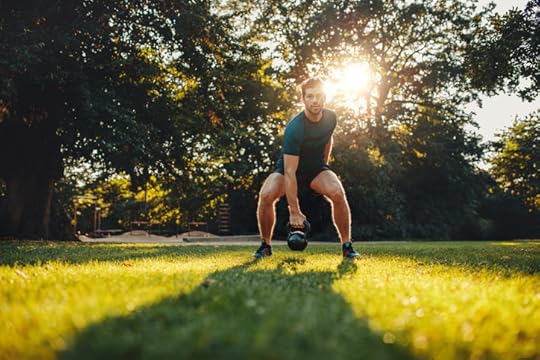 The Primal Blueprint is all about maximizing the efficiency of training to reduce the time spent working and increase the time spent playing. If I can figure out the minimum effective dose and get 80% of the benefits in 20% of the time, I’m all for that. It leaves me extra time to spend with my loved ones, play outdoors, go for hikes, or buckle down and get some work done. Especially if I don’t cut any corners or shortchange myself. This is why I love microworkouts, where instead of spending hours in the gym I just do movements and exercises throughout the day—have “exercise snacks”—and accrue a large training load without feeling like I spent all day in the gym.
The Primal Blueprint is all about maximizing the efficiency of training to reduce the time spent working and increase the time spent playing. If I can figure out the minimum effective dose and get 80% of the benefits in 20% of the time, I’m all for that. It leaves me extra time to spend with my loved ones, play outdoors, go for hikes, or buckle down and get some work done. Especially if I don’t cut any corners or shortchange myself. This is why I love microworkouts, where instead of spending hours in the gym I just do movements and exercises throughout the day—have “exercise snacks”—and accrue a large training load without feeling like I spent all day in the gym.
But microworkouts aren’t the only path to make exercise more efficient, or at least feel that way. There’s also something called rest pause training, or myo rep training.
What is Myo Rep or Rest Pause Training?
The way most people lift weights, they’ll lift a moderately heavy weight for 5-12 reps, rest for a couple minutes, and do another set. They repeat this a few more times. But when you lift this way, the only truly hard reps are the last few of each set. Those last 4-5 reps where you start feeling the burn, where the weight begins to move slowly. Those reps are where the most muscle tension is occurring and where all the muscle fibers are truly engaged. It’s where the adaptations occur. These are the “effective reps.”
What if you could extend that tension and that engagement and pack more “effective reps” into your workouts?
One way is to just do high volume sets—to just lift a lot of weight over and over and over again. This isn’t a viable way for most people. It takes too long, it’s too hard, and it requires too much discipline and drive. You have to really love training to do high-volume, high-intensity lifting. And if that describes you, you’re probably already doing something similar.
Another way is to do myo reps.
Myo reps focus on extending full muscle fiber engagement by starting with an “overload set” and following up with mini-sets, taking very little rest in between so your muscles stay fully engaged and you can squeeze more effective reps into your workout. Here’s how it looks:
Choose a moderate-light weight.A moderate to light weight is ideal because you want to accrue enough volume to really start activating and engaging the muscle fibers. High weight, low reps are great too, but they don’t tend to trigger the “burn” like higher reps do and as such aren’t as suitable for myo rep training.
Do 10-20 reps, stopping at failure or 1-2 reps short of failure.The last 4-5 reps should feel hard. They should burn. This is your overload set or “activation set,” where you hit the point of full muscle fiber activation and engagement.
Rest for 5-7 breaths.Take normal breaths. This should be a 10-15 second rest or so.
Do 3-5 reps.All these reps will feel hard, or you’ll “feel them.” Again, almost to failure.
Rest for 5-7 breaths.Quick rest.
Do the same number of reps you just did in the previous mini-set.If you did 5 reps, do 5 reps again. If you did 4, do 4. 3, do 3.
Complete three more “mini-sets” with the same number of reps and rest periods if you can.If you do one less rep during a set, stop. That’s it. End the set.
You’ll be sore. You’ll be burning. Your muscles will be pumped. You might be shaking. These are good things. These indicate that you have really hit your muscles hard.
Some examples of how it might look:
15/4/4/4/3 — Once the rep count drops by 1 and you can only do 3, you stop.
16/3/3/3/3/3 — Once you hit 5 mini-sets, stop.
20/5/5/4 — Once the mini-set rep count drops, stop.
But those are just examples. You can use any rep scheme as long as you stick to the basics:
10-20 reps (to near failure) for the overload set5-7 breath rest3-5 repsRepeat 4 times, or stop when your reps drop by 1It’s simple and quick but not easy. These are hard — but they’re over fast.
Progress by adding reps. If you’ve been hitting 3-rep mini-sets, progress toward 4 and 5-rep mini-sets.
Progress by adding weight. If you’ve been hitting 20 rep opening sets, increase the weight and go from there.
The real beauty of this is that you don’t get systemic fatigue. This is not high intensity interval training or sprinting or Crossfit-style metabolic conditioning training where your entire body is exhausted. Your heart rate will go up, but the main part of you that fatigues is the muscle itself. That’s where the adaptations come from and it’s why you can keep pushing through the pain: the pain is localized.
If you want to incorporate these types of sets, I would really recommend using them as microworkouts throughout the day. Each myo rep set is an individual microworkout. How I’ve been using them as microworkouts:
10:00 am, push-up myo rep set (20/5/5/5/5/5)
12:00 noon, trap-bar deadlift myo rep set (12/3/3/3/3/3)
2:00 pm, pull-up myo rep set (10/3/3/3/3/3)
3:00 pm, dumbell reverse lunge myo rep set (20/5/5/5/5/5)
Each microworkout takes about 5 minutes, if that. And I’m really feeling each one, and then I’m done. I don’t get injured, I get a nice strong stimulus package sent to my muscles, and I have plenty of time to do the things I love doing throughout the day. Win win.
Of course, you can also just do a normal workout using myo rep sets.
Anyway, if you have any experience with this type of rest-pause or myo-rep set training, I’d love to hear about it.
Do you think you’ll try it yourself?
(function($) { $("#dfaVcge").load("https://www.marksdailyapple.com/wp-ad..." ); })( jQuery ); 
The post Rest Pause Training: How to do Myo Reps appeared first on Mark's Daily Apple.



April 13, 2021
Do You Know How to Properly Hydrate? It’s Not as Straightforward as You Might Think
 Hydration seems like it should be so easy: drink some water, go about your day, the end. Back in this blog’s early days, and when I first published The Primal Blueprint, my hydration advice was simple: drink when you’re thirsty.
Hydration seems like it should be so easy: drink some water, go about your day, the end. Back in this blog’s early days, and when I first published The Primal Blueprint, my hydration advice was simple: drink when you’re thirsty.
Over the years, however, my thinking on the hydration issue has become more nuanced. When I updated and expanded the most recent edition of The Primal Blueprint in 2016, I expanded on that basic advice to include more details about what we should be drinking and how much.
For the most part, I still think that “drink to thirst” is a sound strategy for the average person. Your body has a built-in, well-regulated thirst mechanism that will keep you from becoming dehydrated in normal circumstances. However, some folks, like the endurance athletes in the crowd, would be wise to take a more intentional approach.
Benefits of Proper Hydration and How It’s RegulatedHydration is a critical component of optimal health. Digestion, muscle contraction, circulation, thermoregulation, and neurologic functioning all rely on having appropriate fluid balance in the body.
Your brain and kidneys are constantly working to maintain optimal hydration status. When you become even slightly dehydrated, several things happen. First and foremost, your blood osmolality (concentration) increases. Dehydration can also cause a decrease in blood volume and, often, blood pressure.
The brain and kidneys sense these changes and release hormones and hormone precursors designed to restore homeostasis.https://www.ncbi.nlm.nih.gov/pmc/arti... For example, the pituitary gland releases an anti-diuretic hormone called vasopressin, or AVP, which tells the kidneys to hold on to water. Blood vessels constrict. Most importantly, a brain region known as the lamina terminalis initiates the powerful sensation we know as thirst.
Pay Attention to Your Thirst!For most people, proper hydration is as simple as 1, 2, 3.
1) Tune in to your body’s thirst sensations and respond accordingly.
2) Tailor your fluid intake to your individual needs. Rules like “drink at least eight eight-ounce glasses of water” or “drink half your body weight in ounces” are all well and good, but they might not be right for you. There’s not a lot of scientific support for those nuggets of conventional wisdom. Some days you might need less or considerably more.
3) Make appropriate adjustments for exogenous factors like climate and exercise. When it’s very hot, or you’re sweating buckets during some long endurance event, it’s best to stay on top of hydration rather than waiting for thirst to kick in.
Don’t Become WaterloggedYou can have too much of a good thing. While I’m all about the trend of carrying stainless steel water bottles everywhere we go for environmental reasons, there’s never any call to drink literal gallons of water. In fact, drinking too much can bring about the dangerous condition of hyponatremia, where excess fluid compromises the all-important sodium balance in your blood.
Hyponatremia can quickly become debilitating and even fatal. You may have heard the news stories of novice marathon runners losing consciousness after over-hydrating or radio station contestants drinking themselves to death in water-chugging contests.
By and large, your kidneys can deal with you drinking more water than you need within reasonable limits. You’ll just pee it out. Still, there’s no reason to force yourself to drink water beyond your natural thirst.
Salt: A Hydration GamechangerMaintaining proper fluid balance isn’t just about how much water you have in your body but also the concentration of key minerals, notably sodium. When you become dehydrated, you may experience not only thirst but also salt cravings.https://www.ncbi.nlm.nih.gov/pmc/arti...
Salt continues to get a bad rap, though thankfully the tide of conventional wisdom seems to be turning as more people recognize that salt is not the enemy. Salt—or rather, sodium—is essential in the truest sense of the word. Without enough, and without the right balance between salt and other minerals, our bodies literally cannot function.
Sodium helps transport water through the walls of your small intestines, where 95 percent of fluid absorption takes place. We Primal folks naturally consume less sodium than the average person since a large proportion of most Americans’ dietary sodium comes from hyper-processed foods that we avoid.https://pubmed.ncbi.nlm.nih.gov/19100... For optimal absorption, I recommend adding a pinch of salt to your water, especially if you’re craving the stuff. You can also make a jar of sole (“soh-lay”) water and add up to a teaspoon to a glass of water.
Do You Need to Add Electrolytes to Your Water?Sodium is one of the main electrolytes, along with magnesium and potassium. Most Primal folks will get electrolytes by salting their food and consuming a diet containing nose-to-tail animal products and a diverse array of vegetables.
However, keto dieters and hard-charging athletes or other folks who sweat a lot, like those who work outside in hot climates, probably need to add electrolytes to their water to ensure proper fluid balance. Check out my guide to electrolytes on keto. I’ll talk more about considerations for athletes below.
How to Stay Hydrated Without Drinking WaterThere’s no question that good ol’ fashioned water is the best, most Primal beverage. Some people tell me they don’t like the taste of water. I can’t relate, but if you’re one of those people, you can also meet your hydration needs with a combination of:
Mineral water or any of the sparkling waters on the marketCoffee, regular or decaf (no, coffee and caffeine aren’t dehydrating even during exercisehttps://pubmed.ncbi.nlm.nih.gov/24416... https://pubmed.ncbi.nlm.nih.gov/25154... or iced teaKombuchaBone brothVegetable or fruit juice, though I’d caution you to limit your consumption of the latterStill, I’d encourage you to work on embracing water. Maybe you need a water filter to make your tap water taste better. Try adding sliced citrus fruits, berries, ginger, cucumber, and fresh herbs to a pitcher of water to infuse flavor without a ton of sugar.
Remember, too, that we get up to 20 percent of our hydration needs met through food, especially fruits and vegetables. Carniflex enthusiasts, you still get some water from meat and the limited vegetables you might enjoy, but less than an omnivorous diet provides.
Hydration for AthletesFor athletic types and anyone who goes out and works up a serious sweat, the hydration issue is more complicated.
Athletes who engage in endurance sports such as long-distance running, triathlons, or events such as CrossFit competitions put their bodies under considerable physical and metabolic stress. (I won’t lecture you about chronic cardio here, but you know how I feel about it). They have greater-than-average hydration needs because they are losing fluids through sweat and because they need to be adequately hydrated to perform at a high level. Their muscles, digestive tract, and brain are really counting on water, just when it is becoming depleted.
While some incidental dehydration is inevitable during intense exercise, performance, thermoregulation, and recovery depend on being as well-hydrated as possible. Moreover, in the heat of the moment—no pun intended—it can be difficult to right the ship if fluid balance becomes compromised.
Does “Drink to Thirst” Work for Sports Hydration?Here is where it gets tricky. Athletes need to consider factors including exercise duration and intensity, environment and temperature, training status, heat acclimatization, previous hydration level, diet, and body mass. There is no single best practice for all athletes. However, we can glean some guidelines from the available research.
Many respected scientists, including the inimitable Dr. Timothy Noakes (author of Waterlogged, world-renowned expert on hyponatremia, and low-carb eating enthusiast) and Drs. Marty Hoffman and Kerry Hoffman (Director of Medical Research and Medical Director of the Western States 100-mile endurance run, respectively) still recommend drinking to thirst.https://www.irunfar.com/2012/08/water... They don’t prescribe a hydration schedule or “ounces per hour” guidelines even for extreme endurance athletes.
However, there is also ample evidence that the thirst sensation can be suppressed during exercise, even when athletes are experiencing systemic dehydration.https://www.ncbi.nlm.nih.gov/pmc/arti... Plus, in a long, high-stress event like an Ironman, athletes cmay become too mentally and physically taxed to attend to their thirst.
If you are exercising Primally, you are not putting sustained, intense stress on your body (by design!), so you can safely drink to thirst. Likewise, let thirst guide you if you’re only out pounding the pavement for an hour or two in temperate conditions. If you are exercising for more than a few hours or in extreme conditions, I think it is wise to have a hydration plan. Remind yourself to drink periodically and do so if it feels comfortable. Practice your hydration strategy before race day, making an effort to train in similar weather conditions as you’ll likely encounter on the big day. But by all means, never force yourself to drink, especially not large quantities of water without also replacing lost electrolytes.
What to Drink for Optimal Sports HydrationWhile plain water is ok, you are better off consuming a solution of water, salt, and glucose or sucrose. Wait, did Mark Sisson really just recommend adding sugar to water?!? I did. Hear me out.
For maximal water absorption, the body requires sodium and glucose or sucrose to facilitate the water transport through channels in the small intestine. This sugar is not for fueling, and it’s not a lot. Your fueling needs are a topic for a different post. I’m talking about a solution of 16 ounces of water, a pinch of salt, and a teaspoon of maple syrup (because it has a good composition of sucrose and glucose).
I do not advise relying on engineered “sports nutrition” drinks in general. They are usually more concentrated and higher in carbohydrates than you need. Those of you who have experienced the dreaded sloshing belly during a marathon know how they can sit in your stomach due to slow gastric emptying.https://pubmed.ncbi.nlm.nih.gov/33136... Then, once the sugary fluid is in your digestive tract, your body draws stored water into the intestine to dilute it. This has a net dehydrating rather than a rehydrating effect. Ouch!
What’s more, engineered sports drinks like the ubiquitous Gatorade often have undesirable ingredients that I don’t want in my system. I prefer to make my own hydration drink for long, hot days of Ultimate Frisbee. When I know I’ll be sweating a lot, I also increase my electrolyte intake during or after exercise by salting my food more than usual or using an electrolyte product like LMNT.
Beware the Dehydration Sneak AttackDehydration can also sneak up on athletes who adopt an ambitious training schedule of back-to-back workouts if they aren’t careful about staying on top of their hydrating needs. Brad Kearns, my co-author on many books including Primal Endurance, sustained severe dehydration and an emergency appendectomy after attempting two high-intensity sprint and strength workouts over four days in 100-plus-degree heat.
The lesson here is that as the athlete stacks up big workouts over time, it’s possible to bring a bit of dehydration to the table at successive workouts. Entering a hard workout slightly under-hydrated, then burning up more energy and generating more heat at the workout, might cause a dehydration spiral. Yes, even if you faithfully down fluids right after the workout until your thirst is temporarily quenched, you’ll find yourself in catch-up mode.
Hydration Accommodations for Female AthletesAs Dr. Sims, exercise physiologist, nutrition scientist, and co-founder of Osmo Nutrition reminds us, “Women are not small men.” Most of what researchers “know” about hydration comes from studies of male athletes. Female hormone cycles can profoundly affect women’s hydration needs.
In particular, during the luteal phase (between ovulation and onset of period), when estrogen and progesterone are high, blood volume and total body sodium are low. At the same time, women have lower homeostatic thresholds for AVP release and thirst.https://www.ncbi.nlm.nih.gov/pmc/arti... This means that women are physiologically closer to being hyponatremic, so they have to be particularly careful not to over-hydrate. (This might be why women are at greater risk for exercise-associated hyponatremia.https://cjasn.asnjournals.org/content...)
Dr. Sims advises that women in this phase sodium preload before exercise and hydrate using a water-sodium-sugar solution as described above.https://pubmed.ncbi.nlm.nih.gov/17463...
Designing an Optimal Primal Hydration StrategyBest practices:
For most people, drinking to thirst is still the best recommendation.Drink throughout the day. Keep water handy so it is available if you want it, but don’t force yourself to drink beyond thirst. If you’re constantly drinking water and in the bathroom every 30 minutes, you’re probably just cycling water in and out with no physiological benefit.It’s not enough to drink water; you also have to absorb it. This is where salt comes in. Salt your food to taste, and add a pinch of salt to your water.Eat high-water-content vegetables, plus some fruit if you want.Athletes probably need a more intentional hydration strategy where they plan to check in with their thirst at regular intervals, consume a solution of water + sodium + sucrose or glucose, and replace lost electrolytes. Practice hydration strategies during training to prepare for race day.Female athletes in the luteal phase of their menstrual cycles should consider sodium preloads, particularly before long or hot workouts.Remember, hydration needs and optimal strategies are idiosyncratic. Just as I advise you to experiment with your diet to find what works best for you, do the same with hydration.
Hydration FAQsQ: What foods contain the most water?All food contains some water. Fruits and vegetables contain the most water, so they are the most hydrating. At the top of the list are the ones you’d probably expect: watermelon, cantaloupe, and other melons; lettuce and spinach; berries; celery; and squash.
Q: Does sparkling water hydrate you?Sparkling water, or carbonated mineral water, is just as hydrating as regular water.https://pubmed.ncbi.nlm.nih.gov/26702... Sparkling water makes an ideal substitute for soda if you’re trying to cut back on sugar-sweetened beverages. Mix sparkling water with kombucha for a refreshing mocktail.
Q: Is coffee or decaf coffee dehydrating?Caffeine does have a mild diuretic effect, meaning that it can increase urination. However, the preponderance of evidence confirms that coffee is not dehydrating when consumed in reasonable amounts, meaning two to four cups per day. Go ahead and count your coffee toward your hydration goal.
Q: How do I hydrate fast if I think I might be getting dehydrated?Unless you show signs of serious dehydration, it’s enough to drink water to thirst with a pinch of salt to increase absorption. Signs of dehydration include extreme thirst, dark urine, dizziness, and confusion. See a doctor immediately if symptoms are severe.
Q: Do I need a home water filter? Is a pitcher filter, reverse osmosis system, or whole-house water filter best?Plain water is the best way to hydrate. You may want to invest in a water filtration system if you don’t love your water. Pitcher, under-sink, and whole-house filters can all improve the taste and odor of tap water. Check out my guide: How to Choose the Best Water Filter.
(function($) { $("#df3CHrW").load("https://www.marksdailyapple.com/wp-ad..." ); })( jQuery ); 
The post Do You Know How to Properly Hydrate? It’s Not as Straightforward as You Might Think appeared first on Mark's Daily Apple.



April 12, 2021
Are Salt and Sodium Bad for You?
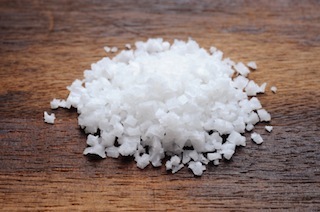 Other than saturated fat, I can’t think of a nutrient that’s been so universally maligned and demonized as salt. All the experts hate it and recommend that we get as little of it as possible. They even all seem to have their own little anti-salt slogans. The American Diabetes Association recommends between 2300 and 1500 mg of sodium per day (“Be Sodium Savvy”). The American Heart Association wants you eating less than 1500 mg per day and claims that 97% of young people already eat way too much salt. The other ADA – the American Dietetic Association – also recommends between 2300 and 1500 mg, but their slogan is far inferior.
Other than saturated fat, I can’t think of a nutrient that’s been so universally maligned and demonized as salt. All the experts hate it and recommend that we get as little of it as possible. They even all seem to have their own little anti-salt slogans. The American Diabetes Association recommends between 2300 and 1500 mg of sodium per day (“Be Sodium Savvy”). The American Heart Association wants you eating less than 1500 mg per day and claims that 97% of young people already eat way too much salt. The other ADA – the American Dietetic Association – also recommends between 2300 and 1500 mg, but their slogan is far inferior.
Why has salt been cast in such a negative light?
Back in the 1980s, researchers launched a massive global study of salt intake and blood pressure called INTERSALT. Overall, it showed a modest association between the two, but some groups, particularly the undeveloped, non-industrial peoples who had very little access to salt (and other trappings of industrialization), had blood pressure that was generally extremely low.
Foremost among these groups were the Yanomami of the Amazon rainforest.https://www.ncbi.nlm.nih.gov/pubmed/1... The Yanomami have very low sodium excretion, which indicates very low sodium intake, and very low blood pressure. Even the elderly Yanomami enjoyed low blood pressure.
Sounds convincing, right? Low salt intake, low lifelong incidence of hypertension – how much more cut and dry can you get? This low salt and low blood pressure connection seemed to also apply to other groups who happened to be living more traditional ways of life.
Except that there’s another non-industrialized group (and you only need one) whose slightly different results kinda muck up the Yanomami argument: the Kuna of Panama.
Among the Kuna, a tribe native to Panama, both salt intake and blood pressure were also historically low well into old age. To study whether the two variables were linked, researchers examined a group of “acculturated” Kunahttps://hyper.ahajournals.org/content... with ample access to salt and an otherwise strict adherence to their traditional way of life. Little changed but the salt intake. in other words. But, despite consuming an average of 2.6 daily teaspoons of salt (and sometimes up to 6 teaspoons), the Kuna did not have hypertension, not even in old age. In other words, there was no change between the hypertensive statuses of 20 year old Kuna and 60 year old Kuna, even though they ate more salt.
All in all, drastic reduction of sodium can reduce blood pressure by a few points. The evidence is pretty consistent on that. But the example of the Kuna shows that there’s way more to blood pressure than how much salt you eat, like how much potassium you eat.
Consider two recent Cochrane meta-analyses. The first,https://www.ncbi.nlm.nih.gov/pubmed/2... on sodium restriction and blood pressure, found that for people with hypertension the mean effect of sodium restriction was -5.39 mm Hg for systolic blood pressure and -2.82 mm Hg for diastolic blood pressure. In normotensive people, the figures were -2.42 mm Hg and -1.00 mm Hg, respectively. Decent reductions, I suppose, but what about potassium and blood pressure?
The upper intake of potassium was associated with over a 7-point drop in systolic blood pressure and a 2-point drop in diastolic blood pressure,https://www.ncbi.nlm.nih.gov/pubmed/2... but only in people with hypertension (the people who actually should lower blood pressure). Unfortunately, the official recommendations for sodium and potassium intake cannot be met simultaneously.https://www.ncbi.nlm.nih.gov/pubmed/2... Yep – the experts want you to eat in a way that is literally impossible to accomplish. Inspires confidence, doesn’t it?
Read next: Electrolytes 101: What Do Electrolytes Do?
Ways Sodium Benefits the Body (You Cannot Live Without It)Here is a selection of scientific studies that show some of the many functions of sodium in your body.
Greater sodium excretion in the urine (a common marker of sodium intake) may be positively associated with large arterial compliance.https://ajh.oxfordjournals.org/conten... Large arterial compliance is a measure of arterial elasticity, or the ability of one’s arteries to handle fluctuations in pressure. Stiffer arteries are more prone to damage.Low sodium status (whether dietarily-induced or caused by increased sodium loss) can increase aldosterone, an adrenal hormone that seeks to preserve sodium in the body when it’s perceived to be scarce. High aldosterone levels are associated with insulin resistance,https://www.ncbi.nlm.nih.gov/pubmed/2... and aldosterone blockers are being explored as potential treatments of vascular diseasehttps://www.ncbi.nlm.nih.gov/pubmed/2... and hypertension.Studies show that sodium loading before exercising in the heat increases fluid volume and reduces the physiological strain of the subsequent training.https://www.ncbi.nlm.nih.gov/pubmed/1... In other words, consuming sodium before training “involved less thermoregulatory and perceived strain during exercise and increased exercise capacity in warm conditions.” You can workout harder, longer, and more effectively with sufficient sodium in your diet. Salt loading also boosts performance in thermoneutral conditions,https://www.ncbi.nlm.nih.gov/pubmed/2... not just hot weather.I remember drinking so much plain water during one race that I actually became dehydrated from excreting out all of my electrolyte stores and almost passed out. From that point on, a few teaspoons of salt would solve the problem and prevent it from occurring again. Bananas didn’t cut it. Only pure, unmitigated salt did the trick. Hardcore ketogenic athlete Dr. Peter Attia does the same with his bullion cubes, which he credits for maintaining his performance.
Salt May Help Your Stress ResponseThis is a guess on my part, based on several lines of evidence. First, salt has been shown to speed up cortisol clearance from the blood.https://www.ncbi.nlm.nih.gov/pubmed/1... The faster you clear cortisol, the quicker you recover from a stressor. If cortisol lingers, you “stay stressed.”
Second, there’s evidence that stress increases salt appetite. In lab mice, activation of the sympathetic nervous system by a stressor causes them to prefer salt water to plain water.https://www.ncbi.nlm.nih.gov/pubmed/8... Similar findings have been observed in rats subjected to stress.https://www.ncbi.nlm.nih.gov/pubmed/1... In humans, acute bouts of stress don’t seem to increase salt appetite, but chronic stress does increase intake of salty, processed junk food.https://www.ncbi.nlm.nih.gov/pubmed/2... Obviously, eating drive-thru fries doesn’t help improve your health, but I find it highly plausible that salting your healthy Primal food to taste could be an important ally against stress. It’s just that when most people need “something salty,” they reach for potato chips, not a couple soft boiled eggs dipped in sea salt.
Third, as I mentioned above, low sodium diets are often associated with elevated stress hormones.
Personally, when I’m up against a deadline, I’m drawn to salty foods – often jerky or macadamia nuts sprinkled with some sea salt. It seems to help.
Limiting Salt Could Have Negative ConsequencesLet’s put blood pressure aside for a second, because there’s way more to health than blood pressure. Plenty of evidence suggests that for many people, all out salt reduction has an overall negative impact on several other aspects of health:
In 2011, one study showed that seven days on a low salt diet increased insulin resistance in healthy men and women when compared to a higher-salt diet.https://www.ncbi.nlm.nih.gov/pubmed/2... also showed that while reducing salt moderately improved the blood pressure of hypertensive patients by a mere 4.18 and 1.98 points for systolic and diastolic, respectively (but not of people with normal blood pressure),https://www.ncbi.nlm.nih.gov/pubmed/1... it also had negative effects on multiple other health markers, including increased triglycerides and LDL and elevated stress hormones.Another 2011 study found that eating a low salt diet (under 3 grams of sodium per day, or just over a teaspoon of salt) and a high salt diet (from 6-7 grams of sodium per day, or well over two teaspoons of salt) both increased the risk of stroke and heart attack, while eating between four and six grams of sodium, or about two teaspoons of salt, each day was associated with the lowest risk of cardiovascular incidents.https://www.sciencedaily.com/releases... found that salt intake followed a J-curve, with low and high intakes increasing arterial plaque formation and a medium intake decreasing it.https://www.ncbi.nlm.nih.gov/pubmed/2... depletion due to “low-sodium nutrition” has been shown to trigger overtraining-like symptoms, including hypertension and sleeping disorders.https://www.ncbi.nlm.nih.gov/pubmed/2... Makes Food Taste BetterYes, some people would claim this attribute as a negative. Adding salt to food will make you more likely to overeat and gain weight and develop the diseases associated with weight gain and so on and so forth. But I’ve always held that eating good food is one of life’s highest, purest pleasures. If your food doesn’t taste good, there’s no point in eating it. We’re not machines concerned only with fuel. We are sensory, sensual beings with the capacity for appreciation of thousands of flavors. To deny the pleasure of food is to deny our humanity.
Salt can also make otherwise unpalatable – but healthy – food somehow palatable. A plate of steamed kale is boring and bitter. A plate of steamed kale with sea salt and avocado oil is delicious and inspiring. Plain broccoli? Kids everywhere are spitting it into napkins and stuffing them into their pockets. Broccoli stir-fried with soy sauce (or tamari, if you please)? Kids everywhere are mailing in their dues (and signing up for auto-pay) for the clean plate club.
You could drop your salt intake to half a teaspoon and get a three or four point drop in your blood pressure. Of course, you might not enjoy your food anymore, your performance in the gym or on the trail would likely suffer, your stress hormones might be elevated, you might start feeling overtrained without doing any actual training, you could become insulin resistant, and you may have trouble clearing (the elevated) cortisol from your blood. But, hey: your blood pressure readings will likely improve by a few points! Or, you could keep your salt intake up around two teaspoons, give or take, simply by salting your food to taste, and avoid all that other stuff.
Your choice.
FAQs About SaltWhat’s a Good Sodium Intake per Day?The Dietary Guidelines for Americans recommends you consume less than 2300 mg of sodium per day.https://www.fda.gov/food/nutrition-ed... Your needs may change if you sweat excessively or if you have specific conditions that affect your electrolyte balance. Talk to your doctor about what makes sense for you.
Is Sodium the Same as Salt?Salt is not pure sodium. Table salt contains around 97% sodium, and other varieties like sea salt and Himalayan pink salt may contain less.
Does Salt Have Calories?Salt has 0 calories per serving.
How Much Sodium Is in a Teaspoon of Salt?
One teaspoon of salt contains 2325 mg of sodium.https://fdc.nal.usda.gov/">21
Symptoms of Too Much Sodium (Hypernatremia)Symptoms of too much sodium may include:http://chemocare.com/chemotherapy/sid...
DizzinessProfuse sweatingFeverVomiting and diarrhea with markedly elevated sodium levels, if your hypernatremia is due to a loss of body fluids.What do you think? Do you fear salt? Do you find your salt appetite increases under certain conditions? Let me know in the comment section!
(function($) { $("#dfUxEIE").load("https://www.marksdailyapple.com/wp-ad..." ); })( jQuery );
The post Are Salt and Sodium Bad for You? appeared first on Mark's Daily Apple.



Mark Sisson's Blog
- Mark Sisson's profile
- 199 followers


